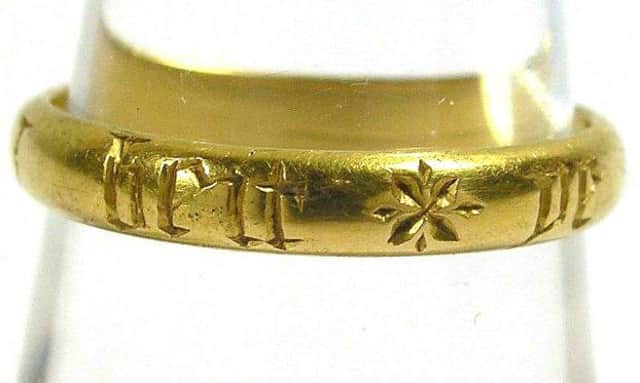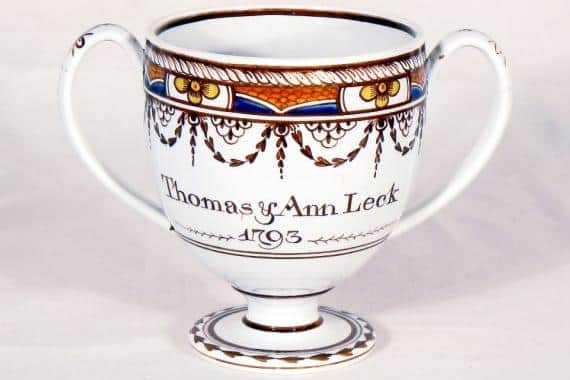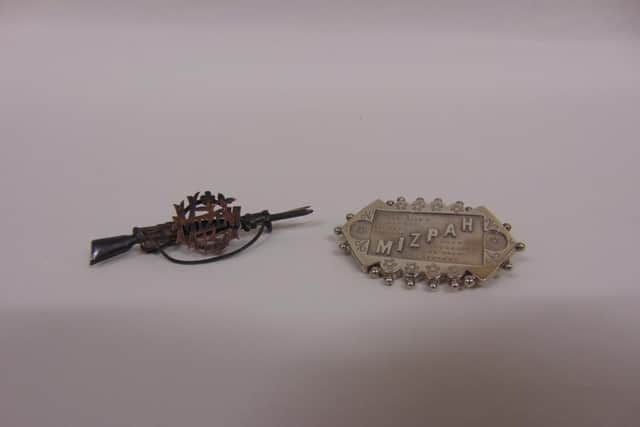Historic South Yorkshire true love stories can still speak to us down the ages


She’s discovered that people in the past experienced very similar obstacles to today’s lockdown lovers, with many couples enduring love at a distance before their happy endings.
Even better for those struggling to be inspired by Valentine’s at home, she’s found that love was rarely conquered with extravagant gestures. It’s usually the simplest things, gifts from the heart, that have stood the test of time.
Advertisement
Hide AdAdvertisement
Hide AdAlthough we can’t visit museums to explore South Yorkshire’s love affair with romance quite yet, Victoria has gathered her favourite objects into a Valentine’s Collection to share with you here.
These stories will also be shared in our History, Health and Happiness online social clubs that are building friendships across Doncaster in a time of physical separation for many. You can even listen to a real-life South Yorkshire wartime romance, recorded as a bite-size audio play and free to download at www.heritagedoncaster.org.uk/projects/happyhistory/doncasters-five-minute-histories
Did you know that South Yorkshire once had an industry devoted to love? In the 18th century, Swinton Pottery manufactured two-handled loving cups that would have been passed around at weddings and banquets.
Although loving cups originated in the macho environment of Anglo-Saxon feasting, they were soon enthusiastically adopted at weddings, so that guests could share a toast for the happy new couple as the cup was passed from hand to hand.
Advertisement
Hide AdAdvertisement
Hide AdSwinton Pottery was founded by Joseph Flint in the 1740s to churn out small-scale domestic earthenware, but by the 1780s had expanded to take advantage of the growing market demand for affordable ceramics, driven largely by the new fashion for tea and coffee drinking.


By the 1820s, Swinton Pottery had been renamed the Rockingham Works and gained an international reputation for its fine porcelain. The firm even designed an elaborate dessert service for the king.
What if true love wasn’t running smoothly? Time to call on Cupid. Two thousand years ago, South Yorkshire’s romantic Romans were no strangers to the spiritual when it came to invigorating their love lives.
They’d wear lucky charms invoking the power of the gods, and just like today, cheeky Cupid, the Roman god of love was a popular talisman. Pagan fertility goddesses were also worshipped as icons on household shrines, just like Rosmerta – not the witch from Harry Potter, but a Celtic deity popular among people from ancient Gaul.


Advertisement
Hide AdAdvertisement
Hide AdLove at a distance might seem like a ‘new normal’ in 2021 but throughout history lovers have been separated, whether by society or circumstance, with no video calling to relieve the heartache.
In medieval England, couples might be betrothed to each other in childhood, but they were expected to enter long periods of public courtship before they could be married – often meaning they weren’t allowed to see other, alone, for years and years.
Not surprisingly, medieval romance is full of stories about the lovelorn, with chivalric knights undertaking thrilling quests to be reunited with their distressed damsels. There’s certainly the promise of an intriguing medieval romance behind the Tickhill Ring. In the 15th century, Tickhill in Doncaster was one of the very few places in the country licensed to hold tournaments, so must have shimmered with knightly fervour and courtly flirtation.
You can imagine the languishing chivalric hero commissioning the exquisite gold ring for his lady, pledging ‘I beit ye teim’ (meaning ‘I bide my time’) as he anticipated the moment his true love would become his wife.
Advertisement
Hide AdAdvertisement
Hide AdWas our hero rejected? The quality of the gold and workmanship suggest the ring was intended as a wedding ring for somebody of high status, not merely a love token, and yet it has very little wear and tear. It must have been lost - or discarded - shortly after it was given to its wearer.
Whether a case of unrequited desire or clumsiness, it ended up unseen and unloved beneath Apy Lane for centuries until it was discovered by modern archaeologists.
By the 1960s marriage rates were peaking after the wartime weddings boom, but so were divorce rates, rising to an unprecedented 30% by the mid-60s.
Times were a-changing and marriage as a conventional institution was being challenged, not least as feminists recognised that it was restricting women’s legal and financial independence.
Advertisement
Hide AdAdvertisement
Hide AdAlthough the Marriage Guidance Council (now Relate) had been founded in 1938, social attitudes to marriage and the role of women were slow to change.
Many British couples would have rejected the idea of marriage counselling, wanting to keep any ‘dirty linen’ in the family.
Instead, the British Medical Association came to the rescue in 1964 with its book Getting Married - a Family Doctor Special. The book contains a series of articles about what to expect in married life, including family planning.
Their top tips for a successful marriage – perhaps just as relevant today - include:
Advertisement
Hide AdAdvertisement
Hide Ad“One of the main things in marriage is to enjoy things together and lovemaking can be the greatest joy of all, so the honeymoon and all married life can truly be spent in the Garden of Eden.”
“Many men find it difficult to appear sympathetic, not because they are unsympathetic but merely because it embarrasses them to express sympathy. However, it is one of those things which women set great store by, so at least make sympathetic noises!”
‘Mizpah’ is something that many of us will be feeling. It’s a word to describe the emotional bond of people who are separated, a Hebrew word that came to mean so much more during the First World War as loved ones were ripped apart.
Mizpah jewellery, with its symbol of two joined hands, experienced a huge surge in popularity during the war years of 1914-1918. It was worn, both by lovers and close friends, to honour the bond of love, and would often have been engraved, sometimes with phrases from the Bible.
Advertisement
Hide AdAdvertisement
Hide AdSoldiers would also send letters, postcards and small gifts from the Front, dreaming of the day they would be reunited with their wives or sweethearts. Sadly, many couples were never reunited.
In one letter, local lad Harry Sharper pledged his love to wife Annie, describing her as the ‘dearest and best little woman on earth’. Although they’d been separated for 10 years, he says that the war has made a different man of him and writes that he’ll devote himself to her and their son, Dixon when he comes home: there will be ‘no deception, no old associates.’ Harry never returned from the trenches to keep his vow.
The tradition of sending letters and gifts home was revived during the Second World War, and it’s clear that sweethearts were never far from soldiers’ hearts.
Doncaster lass May Staniforth was separated from her beau, John Dymond from the Canadian Air Force, during the war. While stationed in Italy he bought her a dreamily romantic pink silk purse, hand decorated.
Advertisement
Hide AdAdvertisement
Hide AdIt was clearly a treasured keepsake – even today, it’s in perfect condition – and it clearly did the trick! Their wedding took place in June 1945, part of an extraordinary craze for getting married at the end of the war. Their love lasted a lifetime.
Will history repeat itself in 2022? With the promise of vaccinations allowing loved ones to be reunited by the end of 2021, wedding planners are gearing up for a boomtime, that might even rival those iconic romantic wartime weddings. For our Happy Ending: Love Conquers All!
In these confusing and worrying times, local journalism is more vital than ever. Thanks to everyone who helps us ask the questions that matter by taking out a digital subscription or buying a paper. We stand together. Nancy Fielder, editor